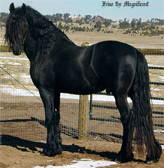What is your horse without a healthy hoof?
Laminitis is an equine condition in which the horse suffers extreme pain and discomfort in their hoofs. The pain and discomfort is brought about by inflammation of the tissue between the hoof wall and coffin bone. The coffin bone is a bone in the horse’s foot, located right behind the hoof wall. As a result of the inflammation, the laminae tissue is no longer able to hold the coffin bone in place, forcing the coffin bone to shift downward towards the bottom of their hoof. This can be extremely painful to the horse, rendering them deficient when walking or galloping.
As horse owners, we never want our horses to be in pain. We always want to provide the best quality care and ensure that our horses stay healthy and happy, whenever possible.
Horse owners can see a spike in laminitis in the fall and winter months, due to the colder temperature and other seasonal factors. Here are some information and tips to help manage and ward off laminitis in the fall and winter months:
Fall And Winter Fructan Laminitis:
The fall and winter months are a tricky time for the horse who suffers from laminitis due to the rise in fructans, which are polymers of fructose found in grass. These fructans can greatly increase the chances of your horse developing laminitis.

A higher rate of fructans develops for many different reasons. A few of these reasons are:
- Drought – fructan levels increase higher and higher in the range of stagnant and non-growing grass.
- Cold weather – cold weather also increases the production of fructans in foliage. A layering of frost on the ground can increase the fructan level to more than three times the normal fructan level.
- Direct sunlight – sunlight is another catalyst for higher fructan levels. Fructans peak at around 4 to 5 pm, leaving horse owners a little wary of a late day pasture.
To read about all of the ways that fructans increase in the fall and winter months, click here.
Major Issues of Fructan Laminitis:
You might be asking yourself, how does higher fructan levels in grass and hay, increase the chances of laminitis for my horse? Well, the answer lies in the hay and grass that horses regularly ingest during the fall and winter months. Due to the rise in fructan levels inherent in the hay and grass, the horses can experience a fructan overload, developing an excess of strep bacteria and an increase in lactic acid.
In addition, the digestion of high fructan grass can lower the pH balance of the large intestine, increasing intestinal acids that can lead to other major health complications.
Within 24 to 36 hours of your horse digesting an inordinate amount of high fructan grass, your horse can develop laminitis, rendering them pain and extreme discomfort, and barring them from enjoying their favorite pastime, running and trotting in your fields.
Possible Treatment of Fructan Laminitis:
You ever hear that baking soda is used for pretty much everything? Well, this is also true in this case.
One way to help ward off the dangers of laminitis for your horse is by balancing out the pH balance in their stomachs with the help of baking soda. Horse owners can dilute approximately one pound of baking soda with water (adding a little sugar-free pancake syrup for flavor), to balance out the pH balance of your horse’s stomach and ward off some of the dangerous bacteria that can grow as a result of an excess of fructans.
Although the exact effectiveness of this treatment is still unknown, there needs to be more studies conducted, we recommend this simple and easy home remedy to be proactive in protecting your horse from the dangers of laminitis.
Horse Heiro Can Help

High fructans can also lead to bacterial overgrowth in your horse’s large intestine. Due to the overgrowth, the intestines become less effective at expelling toxins from the body and the toxins begin to build up causing insulin resistance. Horses with IR are chronically in a state of preexisting pro-inflammation. This leaves them constantly teetering on the edge of tipping into foot pain if any outside event, such as colic or being kicked by another horse, occurs.
Horse Heiro is certified high in Omega-3’s which helps to decrease inflammation. Horse Heiro is veterinarian-developed, 100% all natural supplement using high quality, top-rated natural herbs to help safely and naturally combat elevated Insulin. Heiro contains a proprietary, great tasting, herbal blend exclusive to Heiro containing fenugreek, ocean kelp, blue-green spirulina algae, cinnamon, ginger, willow, peppermint, milk thistle, alfalfa, Vitamin E concentrate, and Magnesium Oxide Mineral. There are no fillers, no artificial colors, preservatives, melamine, pesticides or drugs. This is a great combination and concentrations of organic ingredients to make horses more comfortable and help them get back on grass pasture. The amount of each herb, the part of the plant used to make the herb along with the unique blending process to bring the herbs into a combination with vitamin E and Magnesium.
To read all about laminitis, its causes, and potential complications, or to get your horse on the Heiro program, click here.




; ?>/wp-content/themes/twentyten/img/NMImacLogo_150.jpg)






